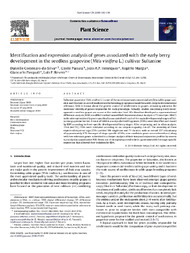Identification and expression analysis of genes associated with the early berry development in the seedless grapevine (Vitis vinifera L.) cultivar Sultanine.
Identification and expression analysis of genes associated with the early berry development in the seedless grapevine (Vitis vinifera L.) cultivar Sultanine.
Author(s): COSTENARO-DA-SILVA, D.; PASSAIA, G.; HENRIQUES, J. A. P.; MARGIS, R.; PASQUALI, G.; REVERS, L. F.
Summary: Sultanine grapevine (Vitis vinifera L.) is one of the most important commercial seedless table-grape varieties and the main source of seedlessness for breeding programs around the world. Despite its commercial relevance, little is known about the genetic control of seedlessness in grapes, remaining unknown the molecular identity of genes responsible for such phenotype. Actually, studies concerning berry development in seedless grapes are scarce at the molecular level. We therefore developed a representational difference analysis (RDA) modified method named Bulk Representational Analysis of Transcripts (BRAT) in the attempt to identify genes specifically associated with each of the main developmental stages of Sultanine grapevine berries. A total of 2400 transcript-derived fragments (TDFs) were identified and cloned by RDA according to three specific developmental berry stages. After sequencing and in silico analysis, 1554 (64.75%) TDFs were validated according to our sequence quality cut-off. The assembly of these expressed sequence tags (ESTs) yielded 504 singletons and 77 clusters, with an overall EST redundancy of approximately 67%. Amongst all stage-specific cDNAs, nine candidate genes were selected and, along with two reference genes, submitted to a deeper analysis of their temporal expression profiles by reverse transcription-quantitative PCR. Seven out of nine genes proved to be in agreement with the stage-specific expression that allowed their isolation by RDA.
Publication year: 2010
Types of publication: Journal article
Unit: Embrapa Grape & Wine
Observation
Some of Embrapa's publications are published as ePub files. To read them, use or download one of the following free software options to your computer or mobile device. Android: Google Play Books; IOS: iBooks; Windows and Linux: Calibre.
Access other publications
Access the Agricultural Research Database (BDPA) to consult Embrapa's full library collection and records.
Visit Embrapa Bookstore to purchase books and other publications sold by Embrapa.

